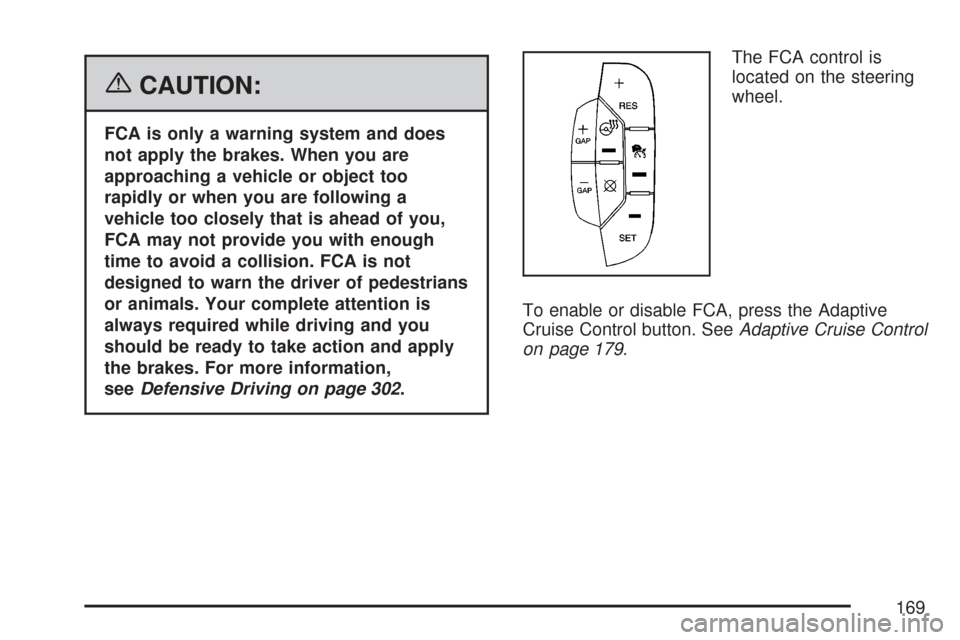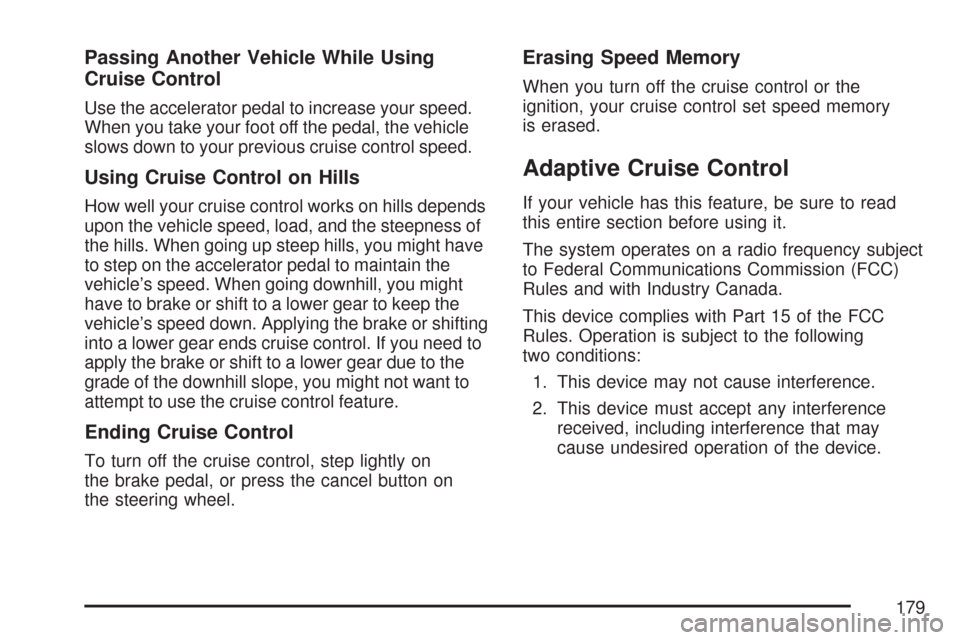wheel CADILLAC DTS PROFESSIONAL 2007 1.G Owner's Manual
[x] Cancel search | Manufacturer: CADILLAC, Model Year: 2007, Model line: DTS PROFESSIONAL, Model: CADILLAC DTS PROFESSIONAL 2007 1.GPages: 518, PDF Size: 2.77 MB
Page 165 of 518

Tilt Wheel
A tilt wheel lets you adjust the steering wheel
before you drive. You can raise the steering wheel
to the highest level to give your legs more room
when you enter and exit the vehicle.
The lever that lets you tilt the steering wheel is
located on the left side of the steering column.
To tilt the wheel, hold the
wheel and pull the lever.
Then move the wheel to
a comfortable position
and release the lever to
lock the wheel in place.
Power Tilt Wheel and Telescopic
Steering Column
If your vehicle has this
feature, the power tilt
wheel control is located
on the left side of the
steering column.
To operate the power tilt feature, push the control
up and the steering wheel will tilt up. Push the
control down and the steering wheel will go down.
Push the control forward and the steering wheel
moves toward the front of the vehicle. Push the
control rearward and the steering wheel moves
toward the rear of the vehicle. To set the memory
position, seeDIC Vehicle Customization on
page 259andMemory Seat, Mirrors and Steering
Wheel on page 12.
165
Page 166 of 518

Heated Steering Wheel
Your vehicle may have a heated steering wheel.
The button for this
feature is located on the
steering wheel.
Press the button to turn the heated steering wheel
on or off. A light on the button will display while
the feature is turned on.
The steering wheel will take about three minutes
to start heating.
Turn Signal/Multifunction Lever
The lever on the left side of the steering column
includes the following:
GTurn and Lane-Change Signals. See
Turn and Lane-Change Signals on page 167.
3Headlamp High/Low-Beam Changer.
SeeHeadlamp High/Low-Beam Changer
on page 167.
Flash-To-Pass Feature. SeeFlash-to-Pass on
page 172.
NWindshield Wipers. SeeWindshield
Wipers on page 172.
LWindshield Washer. SeeWindshield
Washer on page 175.
_Heated Washer Fluid. SeeWindshield
Washer on page 175.
166
Page 169 of 518

{CAUTION:
FCA is only a warning system and does
not apply the brakes. When you are
approaching a vehicle or object too
rapidly or when you are following a
vehicle too closely that is ahead of you,
FCA may not provide you with enough
time to avoid a collision. FCA is not
designed to warn the driver of pedestrians
or animals. Your complete attention is
always required while driving and you
should be ready to take action and apply
the brakes. For more information,
seeDefensive Driving on page 302.The FCA control is
located on the steering
wheel.
To enable or disable FCA, press the Adaptive
Cruise Control button. SeeAdaptive Cruise Control
on page 179.
169
Page 176 of 518

Cruise Control
With cruise control, you can maintain a speed of
approximately 25 mph (40 km/h) or more without
keeping your foot on the accelerator. This is helpful
on long trips. Cruise control does not work at
speeds below about 25 mph (40 km/h). When
cruise control is on, you will see a cruise light
on the instrument panel cluster.
When you apply your brakes, the cruise control
shuts off.{CAUTION:
Cruise control can be dangerous where
you cannot drive safely at a steady speed.
So, do not use your cruise control on
winding roads or in heavy traffic.
Cruise control can be dangerous on
slippery roads. On such roads, fast
changes in tire traction can cause
excessive wheel slip, and you could
lose control. Do not use cruise control
on slippery roads.
If your vehicle is in cruise control when the
Traction Control System (TCS) begins to limit
wheel spin, the cruise control automatically turns
off. SeeTraction Control System (TCS) on
page 309. When road conditions let you safely use
it again, you can turn the cruise control back on.
176
Page 177 of 518

Setting Cruise Control
{CAUTION:
If you leave your cruise control on when
you are not using cruise, you might hit a
button and go into cruise when you do
not want to. You could be startled and
even lose control. Keep the cruise control
switch off until you want to use cruise
control.
The cruise control
buttons are located
on left side of the
steering wheel.
I(On):This position turns on the system.
+ RES (Resume/Accelerate):Press this button
to make the vehicle accelerate or resume to
a previously set speed.
SET– (Set):Press this button to set the speed.
[(Cancel):Press this button to cancel cruise
control.
Cruise control will not work if the parking brake is
set, or if the master cylinder brake �uid level is low.
If the brakes are applied, the cruise control
shuts off.
The cruise light on the instrument panel cluster
comes on after the cruise control has been set to
the desired speed.
1. Press the cruise control button.
2. Get up to the desired speed.
3. Press the SET– button located on the steering
wheel and release it.
4. Take your foot off the accelerator.
177
Page 179 of 518

Passing Another Vehicle While Using
Cruise Control
Use the accelerator pedal to increase your speed.
When you take your foot off the pedal, the vehicle
slows down to your previous cruise control speed.
Using Cruise Control on Hills
How well your cruise control works on hills depends
upon the vehicle speed, load, and the steepness of
the hills. When going up steep hills, you might have
to step on the accelerator pedal to maintain the
vehicle’s speed. When going downhill, you might
have to brake or shift to a lower gear to keep the
vehicle’s speed down. Applying the brake or shifting
into a lower gear ends cruise control. If you need to
apply the brake or shift to a lower gear due to the
grade of the downhill slope, you might not want to
attempt to use the cruise control feature.
Ending Cruise Control
To turn off the cruise control, step lightly on
the brake pedal, or press the cancel button on
the steering wheel.
Erasing Speed Memory
When you turn off the cruise control or the
ignition, your cruise control set speed memory
is erased.
Adaptive Cruise Control
If your vehicle has this feature, be sure to read
this entire section before using it.
The system operates on a radio frequency subject
to Federal Communications Commission (FCC)
Rules and with Industry Canada.
This device complies with Part 15 of the FCC
Rules. Operation is subject to the following
two conditions:
1. This device may not cause interference.
2. This device must accept any interference
received, including interference that may
cause undesired operation of the device.
179
Page 181 of 518

{CAUTION:
On winding roads, Adaptive Cruise
Control may not detect a vehicle
ahead. You could crash into a vehicle
ahead of you. Do not use Adaptive
Cruise Control on winding roads.
Adaptive Cruise Control may not have
time to slow your vehicle enough to
avoid a crash when you are driving
in conditions where vehicles may
suddenly slow or stop ahead of you,
enter your lane, or cross your vehicle’s
path. If you are driving in these
conditions, do not use Adaptive Cruise
Control. The warning beep and alert
symbol may indicate that you are
driving in conditions where Adaptive
Cruise Control should not be used. See
“Alerting the Driver” in this section.
CAUTION: (Continued)
CAUTION: (Continued)
On slippery roads, fast changes in tire
traction can cause needless wheel
spinning, and you could lose control.
Do not use cruise control on slippery
roads.
When weather limits visibility, such as
when in fog, rain, or snow conditions,
Adaptive Cruise Control performance
is limited. There may not be enough
distance to adapt to the changing
traffic conditions. Do not use cruise
control when visibility is low.
181
Page 182 of 518
:This position turns on the system.
+ Resume (Resume/Acc CADILLAC DTS PROFESSIONAL 2007 1.G Owners Manual The Adaptive Cruise
controls are located on
the steering wheel.
The cruise control buttons are located on left side
of the steering wheel.
](On):This position turns on the system.
+ Resume (Resume/Acc](/img/23/7897/w960_7897-181.png)
The Adaptive Cruise
controls are located on
the steering wheel.
The cruise control buttons are located on left side
of the steering wheel.
](On):This position turns on the system.
+ Resume (Resume/Accelerate):Press this
button to make the vehicle resume to a previously
set speed or to increase the set speed when
Adaptive Cruise Control is already active.Set–:Press this button to set the speed or to
decrease the set speed when Adaptive Cruise
Control is already active.
[(Cancel):Press this button to cancel adaptive
cruise control.
+GAP (Increase Following Distance):Press
this button to increase the distance between your
vehicle and other vehicles.
−GAP (Decrease Following Distance):Press
this button to decrease the distance between your
vehicle and other vehicles.
Adaptive cruise control will not work if the master
cylinder brake �uid level is low.
182
Page 183 of 518

Engaging Adaptive Cruise Control With
the Set Button
{CAUTION:
If you leave your Adaptive Cruise Control
switch on when you are not using cruise,
you might hit a button and go into cruise
when you do not want to. You could be
startled and even lose control. Keep the
Adaptive Cruise Control switch off until
you want to use cruise control.
The set speed is selected by the driver. This is the
speed you will travel if there is no vehicle
detected in your path.
To set Adaptive Cruise Control, do the following:
1. Press the
](On) button.
2. Get up to the speed you want.
3. Press in the SET– button and release it.
4. Take your foot off the accelerator pedal.Once Adaptive Cruise Control is set, it may
immediately apply the brakes if it detects a vehicle
ahead is too close or moving slower than your
vehicle.
The on symbol is located on the display at the top
of the instrument panel to the right of the driver.
When the on symbol is lit on the display, it
indicates that Adaptive Cruise Control is active.
A message on the DIC will also display when
Adaptive Cruise Control is set. SeeDIC Warnings
and Messages on page 246.
Keep in mind speed limits, surrounding traffic
speeds, and weather conditions when adjusting
your set speed.
If your vehicle is in Adaptive Cruise Control when
the traction control system begins to limit wheel
spin, the Adaptive Cruise Control will automatically
disengage. SeeTraction Control System (TCS)
on page 309andStabiliTrak
®System on
page 311. When road conditions allow you to
safely use it again, you may turn the Adaptive
Cruise Control back on.
183
Page 185 of 518

Selecting the Follow Distance (GAP)
When the system detects a slower moving vehicle,
it will adjust your vehicle’s speed and maintain
the follow distance (gap) you select.
Use the plus and minus buttons on the steering
wheel to adjust the follow distance.
Press the plus button to increase the distance
or the minus button to decrease the distance.
The �rst button press will show you the current
follow distance setting on the DIC. Your current
follow distance setting will be maintained until you
change it.There are six follow distances to choose from.
The follow distance selection ranges from near
to far (one second to two seconds follow time).
The distance maintained for a selected follow
distance will vary based on vehicle speed.
The faster the vehicle speed the further back
your vehicle will follow. Consider traffic and
weather conditions when selecting the follow
distance. The range of selectable distances may
not be appropriate for all drivers and driving
conditions. If you prefer to travel at a follow
distance farther than Adaptive Cruise Control
allows, disengage the system and drive manually.
185